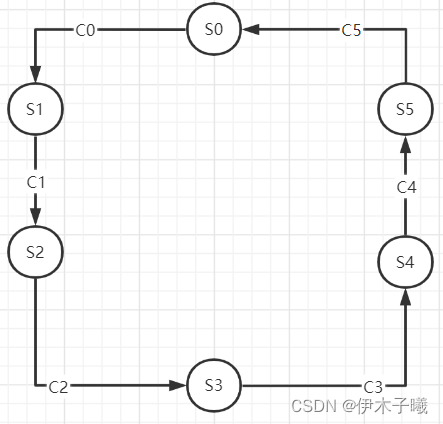任务要求:
1.根据以下描述功能用verilog编写一段代码,并用状态机来实现该功能。
(1)状态机:实现一个测试过程,该过程包括启动准备状态、启动测试、停止测试、查询测试结果、显示测试结果、测试结束返回初始化6个状态;用时间来控制该过程,90秒内完成该过程;
(2)描述状态跳转时间;
(3)编码实现。
2. 画出可以检测10010串的状态图, 并用verilog编程实现之。
一、状态机的种类
1. Moore型状态机
状态机的输出至于当前的状态有关,如下图所示。

2. Mealy型状态机
状态机的输出不仅与当前的状态有关,还与当前的输入有关,如下图所示。

二、状态机要素
1、FSM要安全,稳定性高(最重要,优先级最高),即FSM不会进入死循环,特别是不会进入非预知的状态,即要求FSM的综合实现结果无毛刺等扰动,要求状态机要完备;
2、FSM速度快,满足设计的频率要求;
3、FSM面积小,满足设计的面积要求;
4、FSM设计要清晰易懂,易维护。
三、任务一
-
状态流程图

-
说明
| 序号 | 状态 | 说明 |
|---|---|---|
| S0 | 初始化状态(initial) | |
| S1 | 准备状态(ready) | 准备20秒钟 |
| S2 | 启动状态(start) | 经过15秒测试完成 |
| S3 | 停止状态(stop) | 经过10秒测试结束 |
| S4 | 查询状态(search) | 经过30秒测试结果查询 |
| S5 | 结果状态(display) | 显示10s测试结果 |
| 序号 | 时间 | 说明 |
|---|---|---|
| C0 | 1s | 到S1状态,led0亮 |
| C1 | 21s | 进入S2状态,led0,1亮 |
| C2 | 36s | 进入S3状态,led0,1,2 亮 |
| C3 | 46s | 进入S4状态,led0,1,2,3亮 |
| C4 | 76s | 进入S5结果显示状态 ,led0,1,2,3闪烁 |
| C5 | 86s | 返回S0初始化状态,led都灭 |
- 代码实现
module FSM1_1(
input clk,
input rst_n,
output reg [3:0] led
);
parameter CNT_MAX=49_999_999;//1s
parameter LED_MAX=24_999_999;//0.5s
parameter TIMER_MAX=89; // 90s
reg [25:0] cnt;//计数时间,最大为1s
reg [24:0] led_cnt;//计数led闪烁间隔时间
reg [6:0] timer;//时间s为单位
reg [2:0] state;//当前状态
//6种状态
parameter S0=3'd0,
S1=3'd1,
S2=3'd2,
S3=3'd3,
S4=3'd4,
S5=3'd5;
//时间计数
always@(posedge clk, negedge rst_n)begin
if(!rst_n)begin
cnt<=26'd0;
timer<=7'd0;
end
else if(cnt==CNT_MAX)begin
cnt<=26'd0;
if(timer==TIMER_MAX)
timer<=7'd0;
else
timer<=timer+7'd1;
end
else
cnt<=cnt+25'd1;
end
//状态转换
always@(posedge clk, negedge rst_n)begin
if(!rst_n)
state<=S0;
else
case(state)
S0:begin//inital
if(timer==1)
state<=S1;
else
state<=S0;
end
S1:begin//ready
if(timer==21)
state=S2;
else
state<=state;
end
S2:begin//start
if(timer==36)
state<=S3;
else
state<=state;
end
S3:begin//stop
if(timer==46)
state<=S4;
else
state<=state;
end
S4:begin//search
if(timer==76)
state<=S5;
else
state<=state;
end
S5:begin//display
if(timer==86)
state<=S0;
else
state<=state;
end
default:state<=S0;
endcase
end
//led时间计数
always@(posedge clk, negedge rst_n)begin
if(!rst_n)begin
led_cnt<=25'd0;
end
else if(led_cnt==LED_MAX)begin
led_cnt<=25'd0;
end
else
led_cnt<=led_cnt+25'd1;
end
//led转换
always@(posedge clk, negedge rst_n)begin
if(!rst_n)
led<=4'b0000;
else
case(state)
S0:led<=4'b0000;
S1:led<=4'b0001;
S2:led<=4'b0011;
S3:led<=4'b0111;
S4:led<=4'b1111;
S5:begin
if(led_cnt==LED_MAX)
led<=~led;
else
led<=led;
end
default:led<=4'b0000;
endcase
end
endmodule
四、任务二
-
状态流程图

-
代码实现
module str_detector (
input rst_n,
input clk,
input str,//输入
output reg str_check //输出匹配结果
);
reg [2:0] curr_state ;
reg [2:0] Next_state ;
parameter str_idle = 3'd0, //起始
str_S1 = 3'd1, //1
str_S2 = 3'd2, //10
str_S3 = 3'd3, //100
str_S4 = 3'd4, //1001
str_S5 = 3'd5; //10010
always @(posedge clk or negedge rst_n)
begin
if (!rst_n)
curr_state <= str_idle;
else
curr_state <= Next_state;
end
always @(*)
begin
case(curr_state)
str_idle:
if (str==1)
Next_state = str_S1;
else
Next_state = str_idle;
str_S1:
if (str==0)
Next_state = str_S2;
else
Next_state = str_S1;
str_S2:
if (str==0)
Next_state = str_S3;
else
Next_state = str_S1;
str_S3:
if (str==1)
Next_state = str_S4;
else
Next_state = str_idle;
str_S4:
if (str==1)
Next_state = str_S1;
else
Next_state = str_S5;
str_S5:
if (str==1)
Next_state = str_S1;
else
Next_state = str_S3;
default:
Next_state = str_idle;
endcase
end
always @(posedge clk or negedge rst_n)
begin
if(!rst_n)
str_check <= 1'b0;
else if(curr_state==str_S5)
str_check <= 1'b1;
else
str_check <= 1'b0;
end
endmodule
五、总结
通过本次实验,更加深入的理解了状态机的实现原理,同时也熟悉了通过verilog编写状态机的代码实现流程。